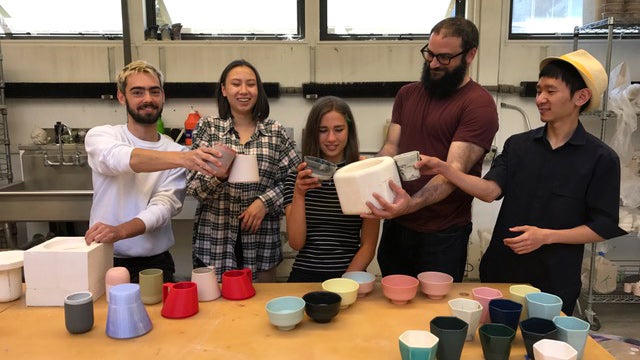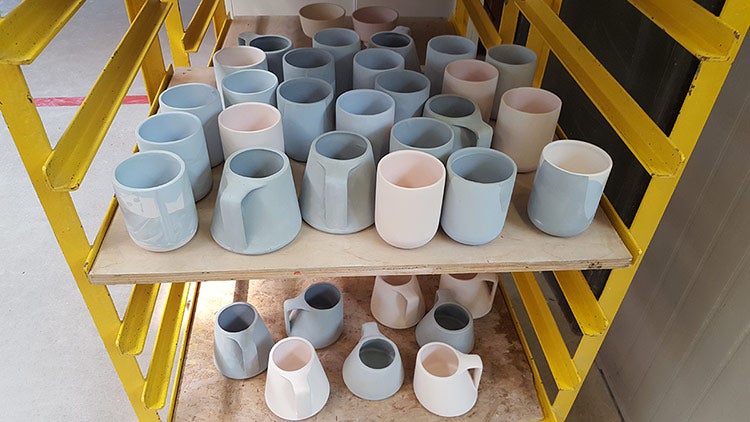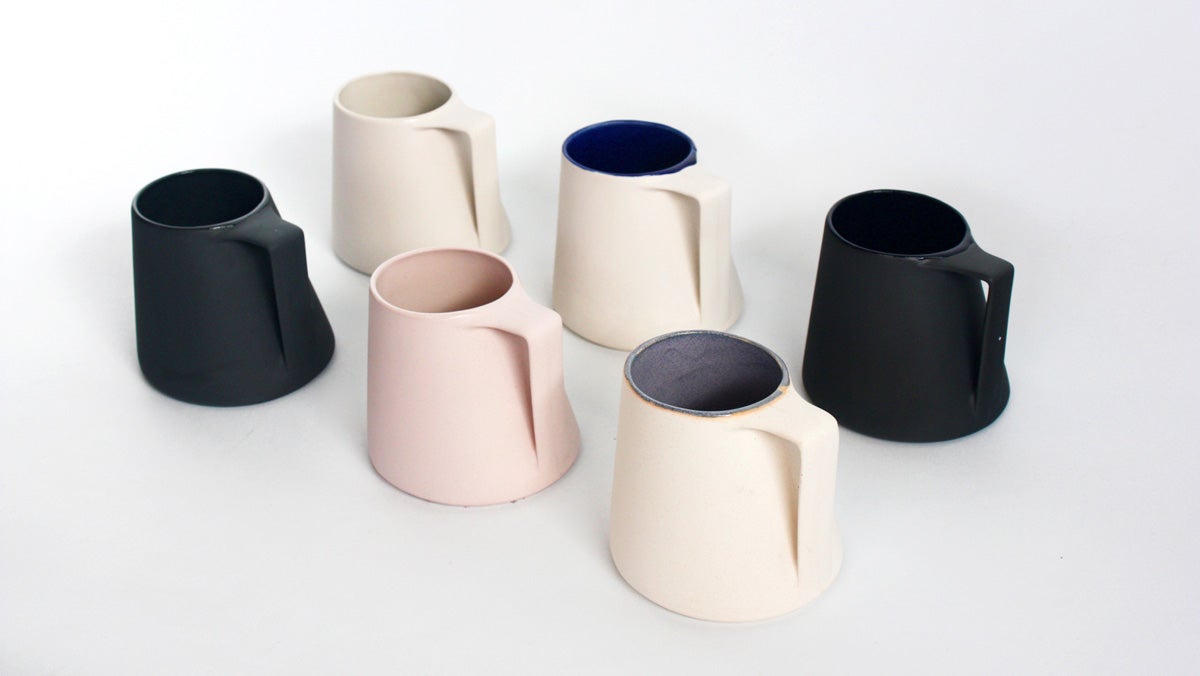 Various evolutions of Aileen Tran’s basic design customize colors and glazes. Photo by Aileen Tran.
Various evolutions of Aileen Tran’s basic design customize colors and glazes. Photo by Aileen Tran.
Nearly 400 new College of Design students will be sipping hot drinks—or perhaps eating cold cereal—from their own brand new cups designed by fellow students last year and produced by hand over the summer.
The cups represent three terms of design and production work by students in an Industrial Ceramics class. In a class competition, the basic designs were selected for production. Students perfected those designs over several iterations during spring term, then, over the summer, one student was hired to produce the cups.
The vessels are intended in part to help students build camaraderie. The cups will be distributed to new students, who are encouraged to show or trade their cups among fellow students “as a means of encouraging introductions and peer networking,” noted Cindy Lundeen, professional outreach manager for College of Design Student Services.
“We hope the cups create a tangible symbol of belonging to our creative, interdisciplinary community,” added Kassia Dellabough, student services director.
A range of colors, clays and glazes along with a variety of casting and glazing strategies have created “an infinite amount of variable forms,” said Associate Professor Brian Gillis, who taught the winter 2017 class.
“Students did considerable research about the school and its various histories and ambitions,” Gillis said, then “moved to formal studies in tin foil, paper, and clay before moving into production models.”
The winning designers are product design undergraduates Yang Li, Julia Sherman, Thomas Sprott and Aileen Tran.
Sprott worked throughout the summer making molds, mixing slip and otherwise producing the 350 cups—one of which edges more toward “bowl status” than a conventional coffee mug.
“I designed my cup to exist in equilibrium between a cup and a bowl,” Sherman said of her design, a café au lait bowl that would be comfortable gracing a French breakfast table. “I wanted to create an object whose function was decided by the user. The ambiguity of the form was the influencing factor that drove the design.”
Tran’s cup, on the other hand, is decidedly a mug. It’s also the only design with a handle, but it’s not a conventional curved handle. It instead takes a 90-degree turn straight down from the rim and attaches at the cup’s wide bottom.
“The handle is the main detail,” Tran said. “The cup is designed to be a playful balance of geometry, to create a handle in harmony with the form. The use of negative space allows shadows to affect the visual appearance of the mug and allows it to look different from every angle.”
Sprott, whose cup offers the simplest of the designs, said he chose “this minimal form to remind incoming students that their work doesn't need to be overly complicated in order for it to be successful. A cup can simply be a cup.”
Sprott’s design is anything but bland. Each version incorporates a custom pattern of abstract lines and swirls that call to mind eddies of a river or an imaginary mountainscape. The shape, too, gently curves near the bottom and tapers toward the lip, motion that repeats in the glaze.
That attention to detail extends to what Sprott hopes recipients of his cups feel when they use the designs he and his classmates crafted.
“What I hope students take away from receiving our cups,” he said, “is the understanding that we really value the physical act of making here in the College of Design.”
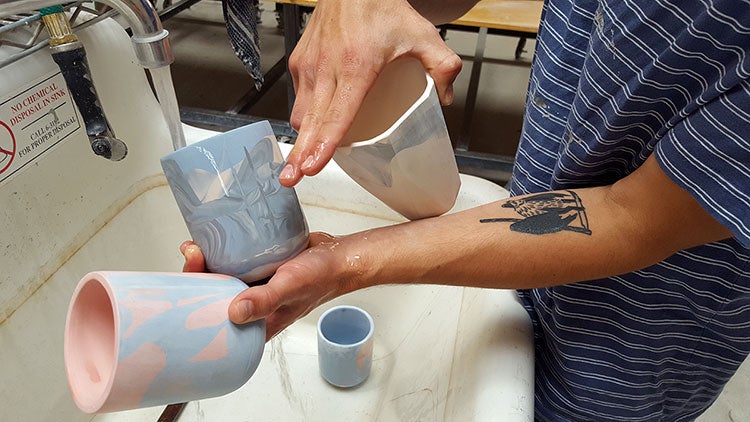 Thomas Sprott’s design incorporates a custom pattern of abstract lines and swirls that call to mind eddies of a river or an imaginary mountainscape. Photo by Marti Gerdes.
Thomas Sprott’s design incorporates a custom pattern of abstract lines and swirls that call to mind eddies of a river or an imaginary mountainscape. Photo by Marti Gerdes.
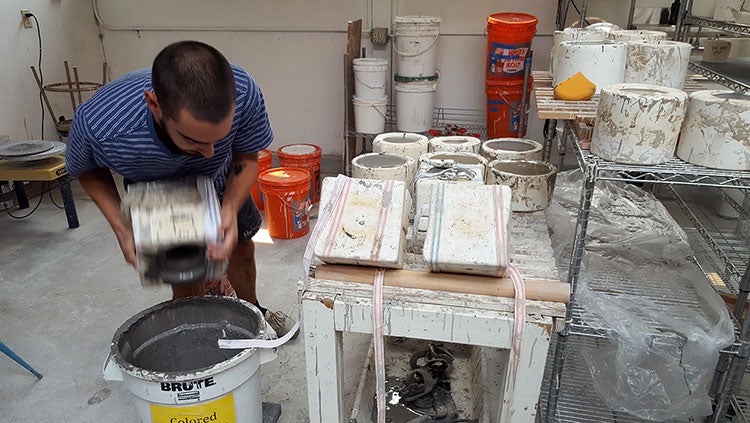 Thomas Sprott spent the summer producing hundreds of cups to be given to incoming College of Design students. Here he pours excess slip from a mold. Photo by Marti Gerdes.
Thomas Sprott spent the summer producing hundreds of cups to be given to incoming College of Design students. Here he pours excess slip from a mold. Photo by Marti Gerdes.
Story by Marti Gerdes

